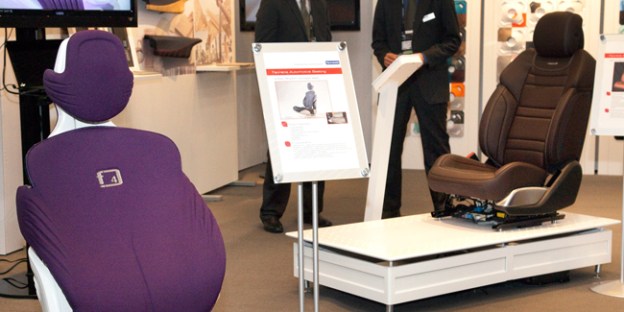
Car seats have come a long way in the last several decades , beginning with overly plush bench seats. Some automakers, like Nash, even made front bench seats that could fold flat, making a twin-size bed inside the vehicle. Buckets and captains chairs slowly replaced those bed-like benches. Eventually, automakers upgraded to the current airbag-laden seats complete with back massagers, extending leg support, and side bolsters that inflate to support your torso during corners. Additionally, nearly every brand-new car seat is electronically controllable, operated either by switches on the side of the seat itself or on the door.
Wired is reporting, however, that French automotive tech company, Faurecia, is looking to take seat tech into the 21st century, and is eagerly pioneering thin, Bluetooth enabled “smart” seats, hoping automakers will bite.
Faurecia identified several issues in today’s automotive seats: thickness and comfort. The Faurecia-designed “bio-sympathetic” automotive seat is 30 mm thick, which stands in stark contrast to most modern automotive seats at 60-120 mm thick. In addition to saving on costly materials, thinner seats could potentially increase performance and fuel economy, two potential benefits that are sure to make automakers grin.

While all these outside-the-box updates to the modern automotive seat seem brilliant, Faurecia made it a bit more complicated. Before you begin adjusting the seat to your ideal configuration, you must first enter your stats: height, weight, etc. Then you must have a friend take photos of you in your seat and activate the accelerometer portion of the seat app by swinging your arms, which in turn gives the app an idea of your reach. Compiling together your weight, your posture, and your arm length, the seat adjusts itself to your ideal driving and comfort settings.
Should drivers suffer from lower back pain or other ailments, which is often aggravated by prolonged sitting/driving, the app also includes a “therapy” function, which provides a tutorial on how to optimize the seat to suit a driver’s individual needs.
When a Faurecia seat recognizes an approaching smartphone user, it will automatically adjust before the driver enters the vehicle. Drivers eager to upgrade and customize their seat can also purchase additional features — like active seat bolsters — for as little as $10, which can then be added to the app and accessed via a smartphone.
Currently, no automakers have adopted Faurecia’s seat technologies, but we wouldn’t be surprised if features like those demonstrated in the SmartFit app make their way into future models.
[Image credit: Wired, Faurecia]
Editors' Recommendations
- Your car insurance company knows more about you than you think
- Car climate controls are better with a knob, but Range Rover does digital right
- Modern cars take touch controls too far. This company found a balance
- 14 awesome flying taxis and cars currently in development
- Kia reportedly put in charge of developing Apple’s first car


